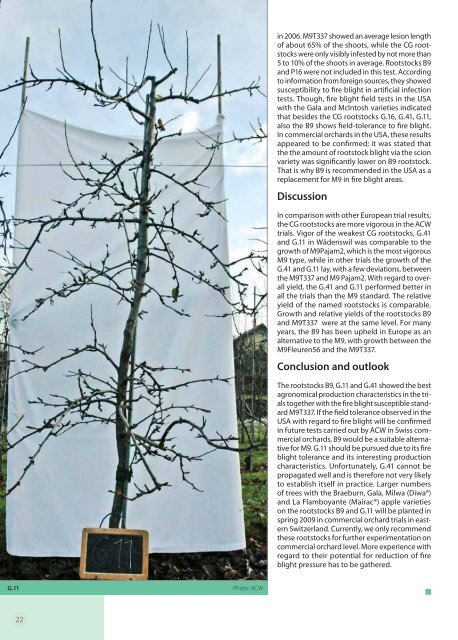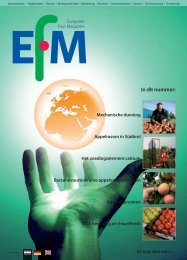In this edition: - The European Fruit Magazine
In this edition: - The European Fruit Magazine
In this edition: - The European Fruit Magazine
Create successful ePaper yourself
Turn your PDF publications into a flip-book with our unique Google optimized e-Paper software.
G.11 Photo: ACW<br />
22<br />
in 2006. M9T337 showed an average lesion length<br />
of about 65% of the shoots, while the CG rootstocks<br />
were only visibly infested by not more than<br />
5 to 10% of the shoots in average. Rootstocks B9<br />
and P16 were not included in <strong>this</strong> test. According<br />
to information from foreign sources, they showed<br />
susceptibility to fi re blight in artifi cial infection<br />
tests. Though, fi re blight fi eld tests in the USA<br />
with the Gala and Mc<strong>In</strong>tosh varieties indicated<br />
that besides the CG rootstocks G.16, G.41, G.11,<br />
also the B9 shows fi eld-tolerance to fi re blight.<br />
<strong>In</strong> commercial orchards in the USA, these results<br />
appeared to be confi rmed; it was stated that<br />
the the amount of rootstock blight via the scion<br />
variety was signifi cantly lower on B9 rootstock.<br />
That is why B9 is recommended in the USA as a<br />
replacement for M9 in fi re blight areas.<br />
Discussion<br />
<strong>In</strong> comparison with other <strong>European</strong> trial results,<br />
the CG rootstocks are more vigorous in the ACW<br />
trials. Vigor of the weakest CG rootstocks, G.41<br />
and G.11 in Wädenswil was comparable to the<br />
growth of M9Pajam2, which is the most vigorous<br />
M9 type, while in other trials the growth of the<br />
G.41 and G.11 lay, with a few deviations, between<br />
the M9T337 and M9 Pajam2. With regard to overall<br />
yield, the G.41 and G.11 performed better in<br />
all the trials than the M9 standard. <strong>The</strong> relative<br />
yield of the named rootstocks is comparable.<br />
Growth and relative yields of the rootstocks B9<br />
and M9T337 were at the same level. For many<br />
years, the B9 has been upheld in Europe as an<br />
alternative to the M9, with growth between the<br />
M9Fleuren56 and the M9T337.<br />
Conclusion and outlook<br />
<strong>The</strong> rootstocks B9, G.11 and G.41 showed the best<br />
agronomical production characteristics in the trials<br />
together with the fi re blight susceptible standard<br />
M9T337. If the fi eld tolerance observed in the<br />
USA with regard to fi re blight will be confi rmed<br />
in future tests carried out by ACW in Swiss commercial<br />
orchards, B9 would be a suitable alternative<br />
for M9. G.11 should be pursued due to its fi re<br />
blight tolerance and its interesting production<br />
characteristics. Unfortunately, G.41 cannot be<br />
propagated well and is therefore not very likely<br />
to establish itself in practice. Larger numbers<br />
of trees with the Braeburn, Gala, Milwa (Diwa®)<br />
and La Flamboyante (Mairac®) apple varieties<br />
on the rootstocks B9 and G.11 will be planted in<br />
spring 2009 in commercial orchard trials in eastern<br />
Switzerland. Currently, we only recommend<br />
these rootstocks for further experimentation on<br />
commercial orchard level. More experience with<br />
regard to their potential for reduction of fi re<br />
blight pressure has to be gathered.



